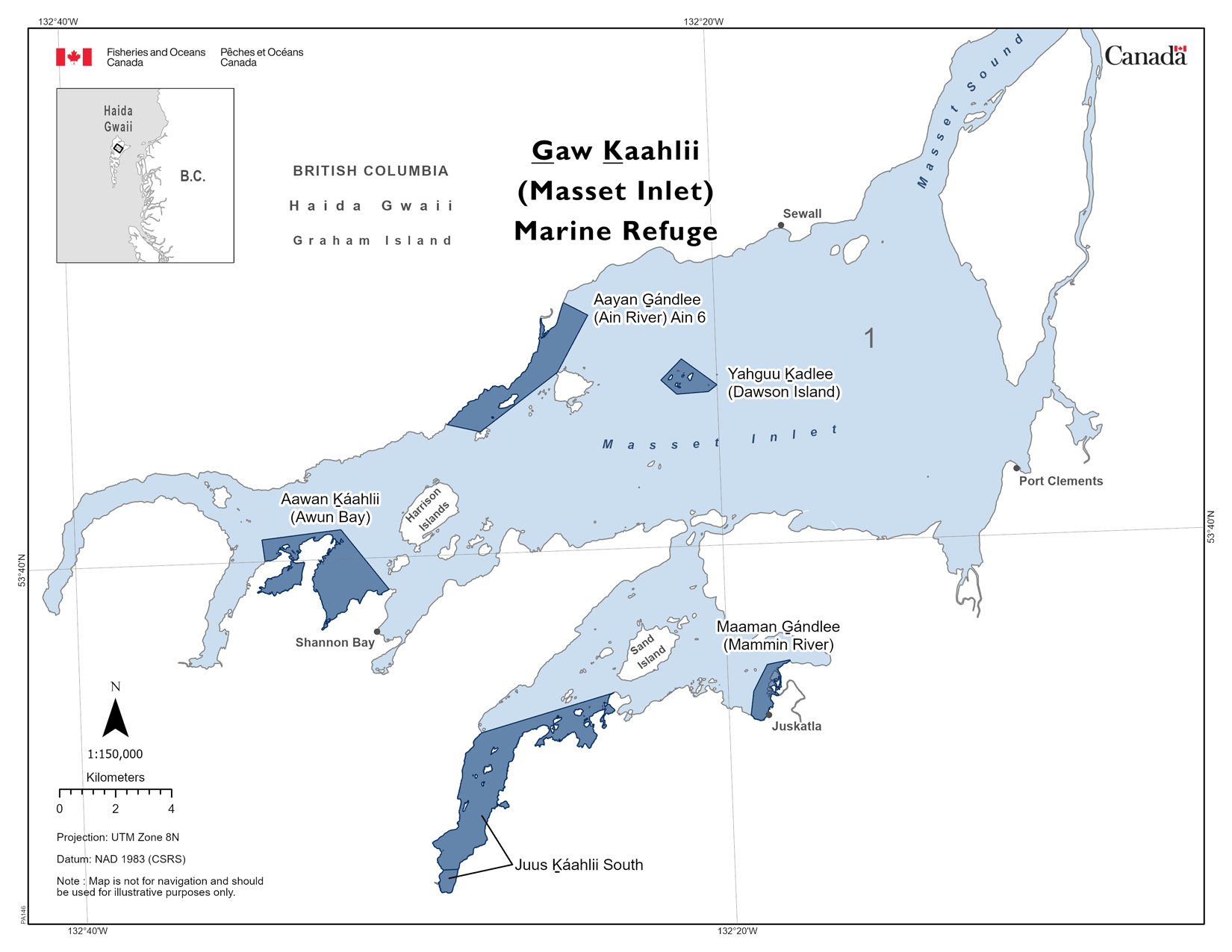G̱aw Ḵáahlii (Masset Inlet) marine refuge
Note:
Charts, diagrams and contact information on this website are provided for information purposes only and should not be used for fishing, navigation or other purposes. Please contact Fisheries and Oceans Canada’s Pacific regional office for official coordinates.
On this page
At-a-glance

Map: G̱aw Ḵáahlii (Masset Inlet) marine refuge
Note:
This marine refuge is within the Northern Shelf Bioregion Marine Protected Area Network Action Plan (NAP). The implementation of the NAP will be advanced and supported by the Great Bear Sea Project Finance for Permanence initiative (endorsed in 2024 by 17 First Nations, the Province of British Columbia, and the Government of Canada). G̱aw Ḵáahlii (Masset Inlet) is among the first of 3 marine refuges recognized under this initiative.
This marine refuge is co-managed by the Council of the Haida Nation and Fisheries and Oceans Canada, and aims to contribute to the identified goals of the NAP.
Location
Northern Shelf Bioregion (Haida Gwaii, British Columbia)
Size (km2) contribution to Marine Conservation Targets
About 22.07 km2
% coverage contribution to Marine Conservation Targets
About <0.01%
Date of recognition
03-11-2025
Establishment mechanism
- Variation Order under the Fisheries Act
- Fisheries Management Direction under the Council of the Haida Nation
Partner First Nation
Council of the Haida Nation
Biodiversity conservation benefits
Protection of ecologically and culturally important species and habitats, including multiple species of salmon, sea birds and their habitat, to contribute to long-term conservation and species biodiversity.
Species of regional importance
Salmon, seabirds, and other important species such as herring and harbour seals.
This marine refuge will contribute to the conservation of a diversity of species, populations and ecological communities, including species of importance to the Haida Nation.
Habitats of regional importance
Eelgrass, kelp beds, estuaries and areas of importance for salmon, seabirds, and killer whales.
This marine refuge will contribute to the protection of species and ecosystems, such as kelp, eelgrass and estuaries that are critical for the life-cycle of many ecologically and culturally important species. Protection of these areas will increase resilience in these habitats to respond to other stressors (e.g., climate change).
Prohibitions
The biodiversity conservation benefits are provided through the following prohibitions:
- no commercial fishing activities are allowed within the areas indicated on the map
- no recreational fishing activities are allowed within the areas indicated on the map (with the exception of shore-based angling, which is permitted)
Other considerations
No human activities that pose risk to the biodiversity conservation benefits may occur or be foreseeable within the area.
Ecosystem
G̱aw Ḵáahlii (Masset Inlet) is an ecologically and culturally important region, with unique oceanography that supports salmon estuaries, kelp beds, herring spawning, killer whale habitat, and is an important region for many migratory bird species.
Prohibition of fishing activities protects eelgrass beds, kelp forests and other habitats. These prohibitions can also protect the services (e.g., refuge, habitat, foraging, nursery) that these areas provide to many pelagic and benthic species.
Related links
- Council of the Haida Nation Fisheries Management Direction – G̲aw K̲aahlii (PDF, 753 KB)
- Council of the Haida Nation: Marine Planning
- Yaaguun G̲andlaay Protected Area Management Plan (PDF, 1,205 KB)
- Haida Gwaii Marine Plan
- Marine Protected Area (MPA) Network Action Plan in the Northern Shelf Bioregion (Great Bear Sea)
- Protecting more of our marine ecosystems together, for future generations | Prime Minister of Canada
- Indigenous-led marine conservation: Project Finance for Permanence
- Date modified: